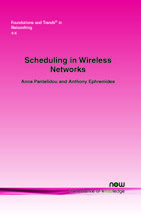Scheduling in Wireless Networks
By Anna Pantelidou, Renesas Mobile Corporation, Finland, anna.pantelidou@renesasmobile.com | Anthony Ephremides, Institute for Systems Research, Department of Electrical and Computer Engineering, University of Maryland, USA, etony@umd.edu
Abstract
We present a review of the problem of scheduled channel access in wireless networks with emphasis on ad hoc and sensor networks as opposed to WiFi, cellular, and infrastructure-based networks. After a brief introduction and problem definition, we examine in detail specific instances of the scheduling problem. These instances differ from each other in a number of ways, including the detailed network model and the objective function or performance criteria. They all share the "layerless" viewpoint that connects the access problem with the physical layer and, occasionally, with the routing layer. This review is intended to provide a reference point for the rich set of problems that arise in the allocation of resources in modern and future networks.
Scheduling in Wireless Networks
Scheduling in Wireless Networks reviews the problem of scheduled channel access in wireless networks with emphasis on ad hoc and sensor networks as opposed to WiFi, cellular, and infrastructure-based networks. After a brief introduction and problem definition, it examines in detail specific instances of the scheduling problem. These instances differ from each other in a number of ways, including the detailed network model and the objective function or performance criteria. They all share the "layerless" viewpoint that connects the access problem with the physical layer and, occasionally, with the routing layer. Scheduling in Wireless Networks is intended to provide a reference point for the rich set of problems that arise in the allocation of resources in modern and future networks.
